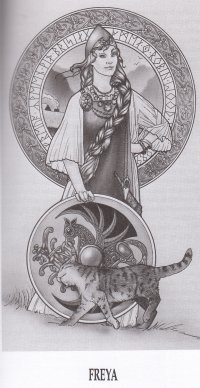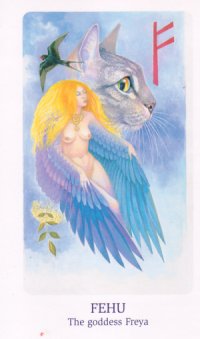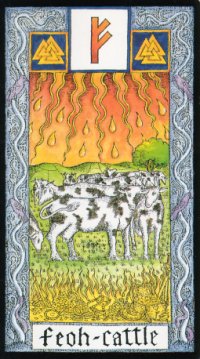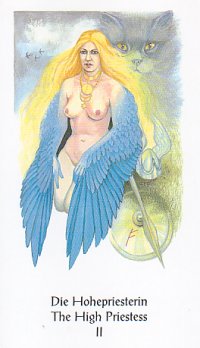
|
FreyjaDevotional and Research Site |

|

|
FreyjaDevotional and Research Site |

|

|
According to the book The Rites of Odin by Ed Fitch (ISBN 0-87542-224-1),
Freya was the
sister of Freyr. Especially in early times, she was very all-encompassing in her attributes,
and seemed to have inherited many of them from various personifications
of the Great Goddess who far preceded the Gods of Valhalla. Freya is famed
for her great beauty, and indeed is often known as "The Fair One". In the
earlier days she also rewarded good housewives, though in later times
Frigga has become more the patron of the home.
Freya is quite independent, being chief of the Valkyries, the demi-goddesses who select the noble and heroic dead and carry them to the Realm of the Gods. Some of the legends say that a quarter or even a half of the dead go to Freya. She is patroness of women who attain wisdom, status, and power, since the Valkyries had been ordinary women, then priestesses, and after being Valkyr became Norns, the Great Goddesses who weave the fates and histories of people and of nations. Freya is the Daughter of Time, as well as the patron and protectress of the human race. On her breast she wears "the jewel whose power cannot be resisted," Brisingamen.Brising meaning fire, specifically the fire of the enlightened mind and men meaning jewel. In ancient times the winter constellation which we today know as Orion was at that time called "Freya's Gown" by the Norse and Teutons, and the sword belt in Orion was called "Freya's Girdle." She is as strong, beautiful and wise as any of the "Eldest Ones." |
|
***According to Norse Mythology - The Myths and Legends of the Nordic
Gods by Arthur Cotterell, Freyja is the daughter of the sea god Njord
and sister of Freyr. She is an important fertility goddess and a member
of the Vanir, one of the 2 branches into which the Germanic gods were
divided. After a war the Vanir seem to have been supplanted by the
younger Aesir, who were led by Odin. When peace was agreed between the
two sides, Njord went with Freyr and Freyja to Asgard, where they lived
with the Aesir as a token of friendship.
Both Odin and Freyja took an interest in the heroic dead, dividing the slain between them at the end of every battle. Odin's share went to live in Valhalla, while Freyja's lived in her hall, Sessrumnir. Freyja flew over the earth, sprinkling morning dew and summer sunlight behind her. She shook spring flowers from her golden hair and wept tears which turned to gold or to amber at sea. It is possible that Freyja's lost husband Odur, or Od, of whom nothing is known but his name, was in fact Odin. For she was the goddess of lust as well as love, a suitable partner for Odin who was the father of battles. Freyja was said to be a sorceress who could fly in a falcon's skin and some traditions state that on her arrival in Asgard she taught the gods the spells and charms of the Vanir (the group of Gods and Goddesses that is older than those of the Aesir). Freyja's greatest treasure was the Brisings' necklace. The Brisingamen neckalce was crafted by four dwarfs with such artistry that it glittered like a constellation of stars in the night sky. Around Freyja's lovely neck it became an emblem of the fruits of the heavens and earth. She in her turn, produced treasures for the earth whenever she cried and Freyja wept profusely, especially during her search for her husband, Odur. When her tears fell on rock, they turned to gold. When shed at sea they turned to amber. It is said that she obtained the necklace by sleeping with the 4 dwarfs.
***Then there's the book titled The Lost Beliefs of Northern Europe it has the following references to Freyja: page 64 - "...while the divine Freyja is something between a lusty giantess and a fair maiden whose white arms light up the darkness of the underworld. Theyh are not sentimentalized and do not become amiable figures, although they may be gift-bearers and bring great benefits to mankind.." page 70 - "Valhalla was never the dwelling place of the universal dead, but intended for outstanding heroes to support Odin in the final battle against giants and monsters, giving him a powerful reason for summoning them to his hall and bringing their careers on earth to a close. Somewhere not far from Asgard was Jutenheim, where dwelt the frost giants who were the enemies of the gods, eager to rob them of their treasures, carry off the fair Freyja and the sun and moon, and destroy Asgard and the inhabited earth. It is less clear where the Vanir dwelt, since the chief gods, Freyr and Njord with a number of others, are represented along with the Aesir in Asgard, but it seems probable that it was in the underworld. There is certainly a link between the Vanir and the land spirits who dwelt in mounds and hills and in water, supernatural beings who befriended some of the earlier settlers in Iceland and probably also between the Vanir and the Elves, who lived on in folk tradition as lesser beings. Most of the goddesses who became the wives of the gods came from the underworld, and were said to be the daughters of giants. The greatest of the goddesses was Freyja, sister of Freyr and daughter of Njord; she is a goddess of many names, and may originally have been the same as Frigg, the wife of Odin, since elsewhere in Germanic tradition we har only of one goddess, Frija (Frigga), who was the wife of the sky god." page 85- 86 - "The goddesses were clearly important in northern religion, yet only Frigg and Freyja play any main part in the tales, while there are brief appearances of Skadi, daughter of Thjazi the giant, Gefion, who plughed the island of Sjaelland out of Sweden, and Idun who guarded the golden apples; it is possible that these last two are to be identified with Freyja under different names. page 107 - "Freyja kept up the sacrificing, for she alone lived on after the gods. (Ynglinga Saga 10)" page 108 - "In Scandinavian tradition the main goddess appears to be Freyja, sister and perhaps als obride of Freyr; the names of these two Vanir deities are really titles, meaning "Lord" and "Lady", and Snorri tells us that Freyja had many other names. There is also the goddess Frigg, wife of Odin and therefore Queen of Heaven, who figures in the myths as the weeping mother, lamenting the fall of her son Balder and later that of Odin, her 'second woe' as Voluspa expresses it. It seems as if these two figures with similar names may indeed be two aspects of the same deity. Sometimes it is Freyja who is paired off with Odin in the tales and she too is represented as a weeping goddess, shedding tears of gold; her tears serve as a favorite poetic symbol for gold in the kennings. Why Freyja weeps is not altogether clear; she is said to be searchign for her husband, of whom we know nothing, but since he is called Od he may be a doublet of Odin." page 108 - "Addional names given by Snorri to Freyja are Mardoll, suggesting a link with the sea; Horn, thought to be related to horr, 'flax'; Gefn, which like Gefion is related to the verb 'to give'; and Syr, 'Sow'. All these names are relevant for the understanding of her cult, for she was connected with water and the sea, and flax was an important crop for which her blessing was sought; she was regarded as a giving goddess, bringing bounty to the fields, animals and mankind, while the sow was the female counterpart of Freyr's symbol, the golden boar. page 109 - "Again Freyja is associated with precious metals; her tears are of gold, and she is a giving goddess, bringing prosperity and riches like her brother Freyr and her father Njord." |

|
The rune card is from Sylvia Gainsford with Howard Rodway's The Rune
Vision Card deck (ISBN 1-84333-023-7).
According to Gainsford and Rodway Runes are divided into three distinct groups called aetts. Numbers 1 - 8 belong to the Goddess Freya/Frejya (same goddess different spellings). Fehu is the 1st rune of the 1st aett. The goddess Freya is depicted with her falcon wings. The feathers grow from her arms, held forward to protect yet reveal her nude feminine form. Freya embodies the sensuality of the lover and mistress, whereas Frigg (card number 14) represents the good wife and mother. Decorating Freya's neck and breast is a gold necklace, an emblem of the stars and the fecundity of the earth. Freya hovers in flight in a sky of soft clouds in which a swallow flies high in the foreground. Beneath the goddess's wings is a spring and flower of the elder, Fehu's tree. Emerging from the clouds is the profile of a grey tabby's cat's head, white whiskers spread forward, its bright-yellow eye gazing ahead. Grey cats are always associated with Freya. At the top right hand corner of this scene is the rune Fehu which is shown in red, the correct colour for this symbol. |
|
According to The Rune Mysteries by Silver RavenWolf and Nigel Jackson
(ISBN: 1-56718-553-3)
Freyja (Frau Frie, Farujo) - is the Golden Bride of the Vanir, and is the Supreme Goddess of the Northern Mysteries, mistress of the inner seith-fire and the religion of Wikkerie (Witchcraft). She is quite similar to Odinn, as she follows the shamanistic ways, possesses psychic abilities, and can shapeshift. As the goddess of love, she governs sexual attraction and emotional interaction, and blesses them with herr Venusian energies. Freyja embodies the quality of Sacred Heat and the warmth of the love that unites all opposites in the world. She often appears in a wanton role in the myths. She is the Otherworld Goddess to whose abode souls travel to be renewed after death. In mediaval German tradition, she is Frau Fri, or Dame Venus, whose sacred mountain, the Venusberg, was the entrance to the Elven realms, and the geomantic Vulva of the Earth. She is associated with the lynx, the extinct Caspian Tiger, and the witches' cat. Freyja is said to wander at night accompanied by silver-gray hares. Hers is the sacred necklace of gold called the Brisingamen, the circle of sunfire whose round is the solar year. She also possesses a shamanic Feather-Skin for traveling in the form of a hawk. Freyja rules the constellations of the Lady's Wain (Ursa Minor) and Freyja's Girdle (Belt of Orion). This Goddess favors amber, and some say that the famed Brisingamen necklace consisted of both amber and gold. |

|
Keeping with The Rune Mysteries card deck
the card associated with her is Feoh: Cattle,
Gold.
Divinities (associated with this card):Freyja, Audhumla, Surt, Niord (Freya's Father), Frey (Freya's Brother). Stone: Carnelian, green tourmaline, amber. Element: Fire Color: Golden red Totems: Cow, linnet, boar, horse Lore: This is the rune of fertility and wealth, cattle and gold, which are the riches of the land and the people. Feoh represents moveable weath, and sometimes, sexual energy. At one time, cattle provided a living for tribal members, and were considered a form of barter. For the peoples of the Northern Way, how many cattle one owned reflected that person's wealth and status within the community. As time progressed, cattle were replaced by inanimate material objects such as gold and silver. Feoh is the primeval golden fire of creation, and represents the all- pervading fertile force of the goddess Freyja. This is the world fire, energizing and initiating the creative process, but which, if blocked or constricted, can become destructive. Depicted on the rune card of Feoh are the flames of Muspal-fire streaming down from the sky of the southern Fire World. These are the primal fires that bring about creation and new beginnings, that gave birth to the genesis of the worlds. Golden and amber droplets also descend upon the earth, representing the precious tears shed by the fertile goddess Freyja. The amber tears are the essence of all abundant wealth.Amber also represents the wealth of magickal spirituality in the world of the adept magickal individual. Freyja wears a magickal necklace of amber, called Brisingamen. In the Witan- Witch Tradition (an many other Witchcraft traditions as well) amber is worn by the High Priestess or 3rd degree initiate to signify her capabilities as a magickal practitioner and leader. Keywords for this rune: Physical - money, wealth, sexual passion. Mental - sense of self-worth, ego. Spiritual - karma. |

|
The Rune Mysteries also list Cen (aka Ken or Torch) as under
Freyja's dominion.
Color: Orange, amber Totems: Lynx, falcon Divinity: Freyja Stones:Flint, smoky-quartz, fire-agate, amber Lore: Cen is the rune of the brightly burning torch that lights up the hall in the evening, whose flames represent the safe, tempered fire of the hearth. Cen depicts the magickal-sexual heat of the goddess Freyja, which slumbers within ourselves, waiting to be kindled. This feminine power is termed Seid-fire or Seith-Fyr, and is the creative force of the Lady.... the word Shaman (once written as Flaman), means "keeper of the burning fires," or "keeper of the flame." The Cen rune is a magickal heat, begetting and shaping new creations, underlying all acts of art, craft, and magick. In the design of the card, the Goddess Freyja is shown with her sacred cats, the classic familiars of traditional witches. She wears the falcon feather cloak that enables her to fly in falcon shape. Encircling her neck is the fire necklace, Brisingamen, forged by four dwarves show at work in their smithy, deep in the caverns. To gain this treasure, Freyja entered into a short marriage with each dwarf. The necklace embodies the circle of sacred fire, created as the sun passes through the four seasonal quarter. Keywords: Physical - documents, letters, books or other recorded information, sexual power. Mental - Insight, success, creativity. Spiritual - Enlightenment. On a spiritual level, Cen represents the spiritual opening. In old Pagan religions, it was a symbol of royalty, aristocracy, and mystery, indicating that the spirits guided believers along their chosen path. Therefore, it was the emblem of the Witch Queen and Wizard King. |
IIa. Other Rune ReferencesAccording to Northern Mysteries - Runes, Gods and Feminine Powers by Freya Aswynn: page 10 - "On a deeper level of kenning, Fehu is related to the Vanir deities Niord, Frey and Freyja. Niord is the god directly related to wealth. He is the god to invoke if you need help in extricating yourself from financial difficulties. Frey and Freyja are fertility deities directly connected with livestock and especially with the newly born cattle in spring. Freyja wears a necklace named Brisingamen, which is a symbol of fertility. Tradition tells us that this necklace is of gold or amber, both costly materials. Freyja had to earn her right to this necklace by sleeping with 4 dwarves, who represent the 4 elements of earth, air, fire and water which working together in balance, engender fertility. One of Freyja's nicknames is Syr which means 'sow'. A female pig is an excellent fertility symbol." page 31 - "There are some German authorities, like Gorsleben, who state that the goddess Freyja has a connection with Kenaz (aka-Cen, Ken). It took me a long time to understand his reasoning. However, there is an obscure link with the feminine Mysteries which can be explained in the following way: Freyja teaches Odin seidr, which is a form of witchcraft and includes "sex magic". page 53 - "The element related to this rune - Jera - is earth; the gods who are associated with it (apart from Baldur and Hodur, who have already been mentioned) are the Vanir twins, Frey and Freyja. The Jera rune is strongly connected with fertility, in particular the fertility of crops." page 61 - "My research indicates that since Algiz has a female and male form, the twins also may be male and female. The assumption that these twins are male is probably due to the fact that most serious rune-workers have been male. They have overlooked the possibility that the twins could be Frey and Freyja. Alternatively, as this sign is one of the oldest of all the extant runes, it may even represent the original twin divinity, from which all others have been extrapolated. Other twin deities include Niord and Nethus, and Ziu and Zisa." page 75 - "...Ehwaz....According to Scandinavian sources, Frey, the god of male fertility, was associated with the horse-cult, as was his sister Freyja, the patroness of volvas. They were said to wear horse-masks and supposedly had the ability to assume mare-shapes, in which they could roam about as 'nightmares'. page 81 - "Laguz means sorcery, which is one of the rune's functions. Sorcery or seidr was, in particular, practiced in the Vanir cult; It is Freyja who introducted sorcery to the Aesir, teaching it to Odin. Laguz meaning lake, water or sea, interpreted according to modern occult thinking may reflect the astral substance. page 111 - "The aett of Frey and Freyja is primarily related to practical and mundane matters. The 2nd aett, the aett of Hagalaz, principally corresponds to emotional matters and the 3rd aett may be used to inquire about esoteric matters. page 131 - "Fehu - Wealth, luck, responsibility and creative energy are implied in Fehu. Its primary element is fire; its secondary element is earth (fire expressed through earth). The ruling gods are the Vanir, in particular Niord, Frey and Freyja. The gender of this rune is female. The power of Fehu gives the practitioner the initial pwoer to start a working. It contains the power of the creative and generative aspects of fire, as opposed to the destructive power of fire. It can be used to draw energy in for a given magical operation, and also as an energy to send, acting more or less as the moving force behind a working. page 133 - "Kenaz means kinship, learning and teaching - the quest for knowledge and the passing on of this knowledge through successive generations. The practical magical use of this rune is in gaining occult knowledge from other planes. Kenaz can thus be used for astral or shamanic travel, either to the higher astral worlds or to the shamanic underworld. The way the rune is used in this context is as a beacon to light the way and enable a safe return to everyday consciousness. Kenaz also is linked with the element of fire, in its most beneficial form. Gods associated with this rune are Baldur, Heimdal and the Goddess Freyja. Kenaz can be used to expose all that is hidden. page 139 - "Folkvang - Field of Warriors, nine castles belonging to Freyja. Here Freyja gathers her share of the slain warriors. Freyja is one of a pair of twins." page 146 - "Inguz corresponds to the element of earth, fertility and the Vanir twins, Freyja and Frey. Therefore this rune goes in the West. According to Creed of Iron (ISBN:0-9678123-0-5) the rune associated with Freyja is Berkano (first reference to this rune I've come across). |

|
Howard Rodway (see above for The Rune Vision Cards) did a deck
called Tarot of the Northern Shadows (ISBN 3-905219-12-3).
Now its interesting that this is the first reference I have that
Freya is associated with the High Priestess (which I think is a
correct association) because I've found that Freya is also associated
with the Magician (Haindl's deck) in Tarot (mainly because the Magician is linked
to Peoh (Fehu) and Cen (Ken) is associated with the number 6 card -
the Lovers (Haindl's deck). So, let's go through each one and see how they relate
to Freyja.
Here's what Rodway says of High Priestess: A wise woman. A teacher. A prophetic woman who gives sound advice. Wisdom. Perception. Intuition. A positive, guiding force and influence. Serenity. Learning. Illumination. Foresight. Psychic abilities. Natural forces. Artistic and creative abilities. Intelligence. Avoiding emotional ties. Emotionally in control. Sometimes showing a cruel or vindictive nature. Moon and Water |

